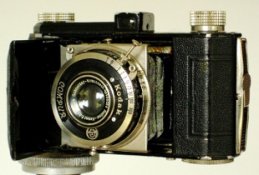Amazing that some of you old guys who were around prior to or after WWII did not chime in. Before WWII there were few, if any 1 frame 35mm cameras and these were more speicalty cameras than mainstream wuch as Robot and Tessena. During WWII film became a military commodity like so many other things and subject to consumer and export controls. After the war, most of the film production facilities outside of the US and UK were destroyed and the needed chemicals were subject to controls. As a result, film was both scarce and expensive in many markets, Japan being 1 of them. The US brass controlling the rebuilding of Japan knew that the boys over there had the German glass formula and did not have the cold war problems and rebuilding issues plaguing the other former AXIS powers so one of the industries slated for being rebuilt were related to photography as it had a ready market and the US camera manufacturers were not a strong lobbying force. The film problem was an issue though as could choke the rebuilding effort. The Japanese developed the 1 frame camera format to get the most images per footage and to bring down the cost per frame since the price of film was very high.
Hence, Japan began to make and market the 1/2 frame camera in its market and soon after to the US service personnel through the PX and finally got permission to export them. The problem was most makers could not grind the lenses to the quality needed to make a good lens for the format so most did not concentrate on the format. Olympus was able to obtain the German glass formula glass from, my understanding Nikon, and concentrated on learning to grind glass to the needed levels to make a good 1/2 lens. Where others failed of had limited success, Olympus succeeded and came out with its line of cameras. It was highly successful as a format in Japan and at least in the US market as they were sold through the PX at prices today we'd drool for and they also were able to establish and maintain a good distribution system in the US. But, with controls finally being lifted and film becoming plentiful and at reduced prices, the economizing of film declined and the market once again returned to 2 frame 35mm as the preferred format. Kodak, during the 1.2 frame period marketed 12 frame film so the 1/2 frame camera could produce 24 exposures. Here in the US they also introduced it but as a film for the realtors so they could have short roll abilities to photograph 1 home and have the film developed but, it was short lived. I can not remember the emulsion but it was not to my liking.
I got caught up in the 1/2 frame collector market in the early '80s when everyone and his brother were trading them for the 1 frame cameras and you had your pick on an average of $5 per camera. I had just about 1 of every model from Olympus including the Pen F lineup that I fell in love with. I also had the Konica Autoreflex that was switchable between the 1 and 2 frame format and an Alpa body plus others from Japan and 1 of the Exacta 1/2 frame bodies. About 1990, the Olympus rep that covered NYC and FL was running around collecting the PEN - F cameras, accessories and lenses at prices indicating he knew something no one else seemed to. The local dealer knew of my collection and called to see if I wanted to sell. I explained I'd be interest but only a complete buyout of all my collection of 1/2 frames and the Exacta collection for a decent MF system and a small 35mm camera as well as something I always wanted, a Minox LX. We cut the deal for a nearly new Bronica ETRS system, a Minox ML 35mm camera and an LX. I later learned that the doctors in NY were clamoring for F sereis bodies to backup the F dental body that was no longer made and were willing to pay almost anything for them as they were used on their microscopes and other instruments.
I have since acquired a Konica AA-35 1/2 frame and from time to time still use it when I want a shirt pocket film camera. It is not up to the quality of the Oly glass but, still very good as a daily user.
They are still realtively inexpensive on the used market so, if you've never tried 1, go for it. Admittedly a 1 frame slide ain't up to a 645 slide but at the average home viewing difference you won't lose much against a 2 fram slide. Only shortcoming is spending the time mounting the slides as most labs today do not carry the slide frames that are 35mm outside dimention but for the 1 frame format so they can be used with most slide projectors.





